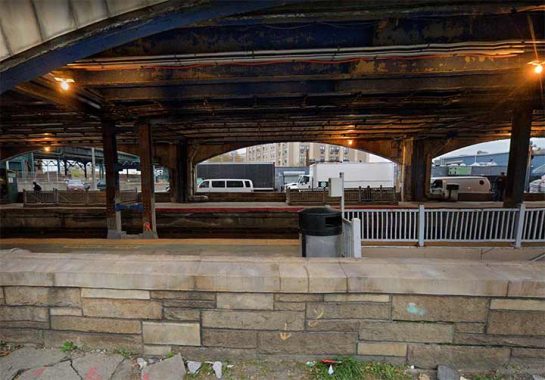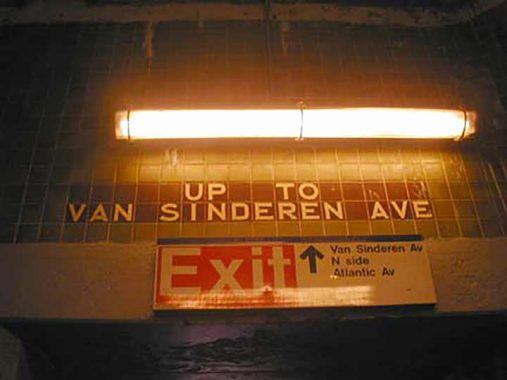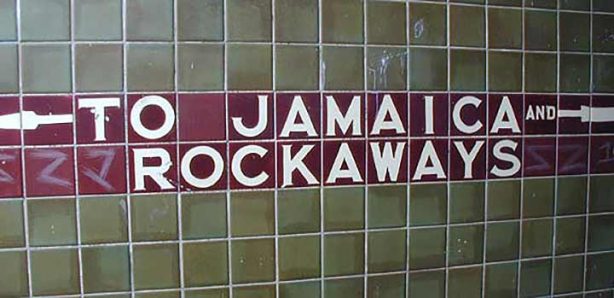
I haven’t been out to East New York for awhile, but fortunately I have a number of photos on file, and I remembered the East New York Long Island Rail Road station, outwardly one of the more decrepit-looking stations in the entire system; many of the stations in open cuts, including Murray Hill on my own Port Washington branch, are hard to maintain. East New York seems to be in a class of its own, though. It’s located at Atlantic and Van Sinderen Avenues and is actually at grade level, with the LIRR entering and exiting tunnels on both sides.
For a century until 1940 the LIRR ran at grade most of the way down Atlantic Avenue, except for a short tunnel to the waterfront on the west, some of which is actually still in place (the late Bob Diamond would occasionally run tours in it until the city and the FDNY ended them). Beginning in 1905 the city wanted to end grade crossings and so put much of the Atlantic Branch in a tunnel or on an elevated overpass, depending on how high the ground, while continuing to run at grade east of East New York until 1940. [thanks Andy Sparberg] At East New York a complicated arrangement developed with the station placed at grade but covered by an auto viaduct.
In the title card you see one of the the subway-like entrances on Van Sinderen Avenue that undercut the Atlantic Avenue roadway and bring passengers to staircases to the platforms.

Here you see the platforms with the staircases in the distance. Bare bulbs without glass reflectors light the platform, likely because vandals would make quick work of any glass coverings. During the day, natural light suffices.

A view of the platform from Atlantic Avenue.


For me the most fascinating aspect is the use of IND-type subway signage, the black and white squares and arrows used for directional signage.
The “Rockaways” refer to the LIRR service to the Rockaways across Jamaica Bay that ran until the original trestle burned down in 1950. The city rebuilt it and used it for IND service in 1956. Because trains to Far Rockaway make this stop, the sign still applies.
As always, “comment…as you see fit.” I earn a small payment when you click on any ad on the site.
7/2/22


16 comments
Reverse commuters make up almost all of the ridership. According to a 2017 report, the most recent I could find, on an average weekday the station gets 679 eastbound riders but only 30 heading to Atlantic Terminal. While those numbers are certainly lower now because of Covid there’s no reason to believe the proportions are any different.
Nostrand Avenue is surely even more skewed towards reverse commuters.
May I make a few of additional points?
In 1940 the LIRR Atlantic Branch was at grade only to east of the East New York Station, towards Jamaica. Going west, towards today’s Atlantic Terminal, the tracks were already grade separated because the current series of tunnels and viaducts between East New York and Atlantic Terminal (originally Flatbush Avenue) were put in service about 1905.
The current East New York station is part of the 1940 grade separation project that removed the LIRR tracks from Atlantic Avenue’s surface going eastward. Tracks were placed in a subway-like tunnel all the way to Boland’s Landing, about a mile west of Jamaica Station. Going west, the tracks emerge briefly at East New York, so that’s why Atlantic Avenue is carried over the station on its own viaduct. Besides the viaduct, the BMT Canarsie Line passes over at a higher level, making the station platforms especially dark even on bright days.
Trains to and from Far Rockaway still stop at East New York, but that pattern will change later in 2022 as those trains are rerouted to Grand Central and the Jamaica-Brooklyn service, under present plans, becomes a shuttle with only a few though trains to and from points east of Jamaica.
East Side Access is proving to be a fiasco because Port Washington service to Penn will be cut in half per hour.
East Side Access has long since proven itself to be a fiasco. It should have been done years ago, and now it’s been WFH’ed into obsolescence before it’s even opened.
This stop has always given me the willies. You’ve evoked it well!
Trains to Far Rockaway do service this station
Perfect for shooting a Charles Bronson movie playing a vigilante shooting muggers
I know this station pretty well. There seems to be a portion of the station platform deep in the tunnel that was closed off to passengers. Its in plain sight from passing trains. I’m guessing it was closed off for safety reasons.
I don’t care what the so-called “facts” say. You’ll never convince me that station is at street-level:)
I’m I’m not mistaken there’s a switching (interlocking)tower below the station as well
That station would be used more if people felt safe in it. I personally rather take the J train to jamaica to hop on the LIRR there. The J Train is within walking distance as is the L, A, and C.
I stopped using the station after witnessing multiple people get robbed at the same time, lucky for me I was walking onto the platform when I saw it and was able to double back while calling 911.
The lighting is horrible, sometimes the entry ways are full of trash. I use to complain to the MTA all the time about this station to no avail, I use it a lot to go downtown Brooklyn as well as did many other people, but it’s just not a safe station. It should have 24 police at this station.
According to Wikipedia, (https://en.wikipedia.org/wiki/Atlantic_Branch) the trains ran elevated from East New York to Atkins Av. from about 1905 to 1942. I have also seen old photos of the structure.
There is a freight, partially abandoned railroad that passes under it by that area. It is connected to the Hell Gate Bridge. I believe they want to use it as part of that Cross Borough railroad or whatever they’re calling it.
And, Peter is right. Not being connected to Manhattan kills some ridership.
That, and the fact that there are Taliban run towns in Iraq safer than this neighborhood.
Yes some people had their heads block or broken .
scary place in the seventies…passing through the tunnel as a kid I encountered a dead body…
That area is like a street and railroad layer cake since East NY Avenue has dive under the LIRR Atlantic branch but also clear the NY & Atlantic (LIRR) Bay Ridge line tunnel